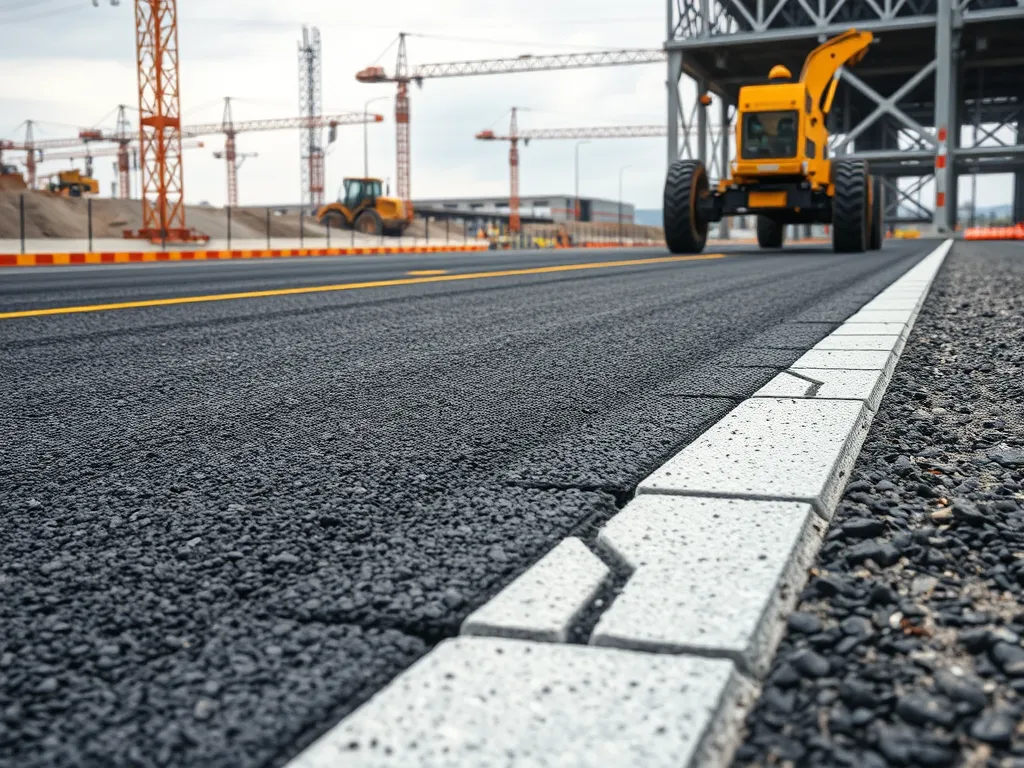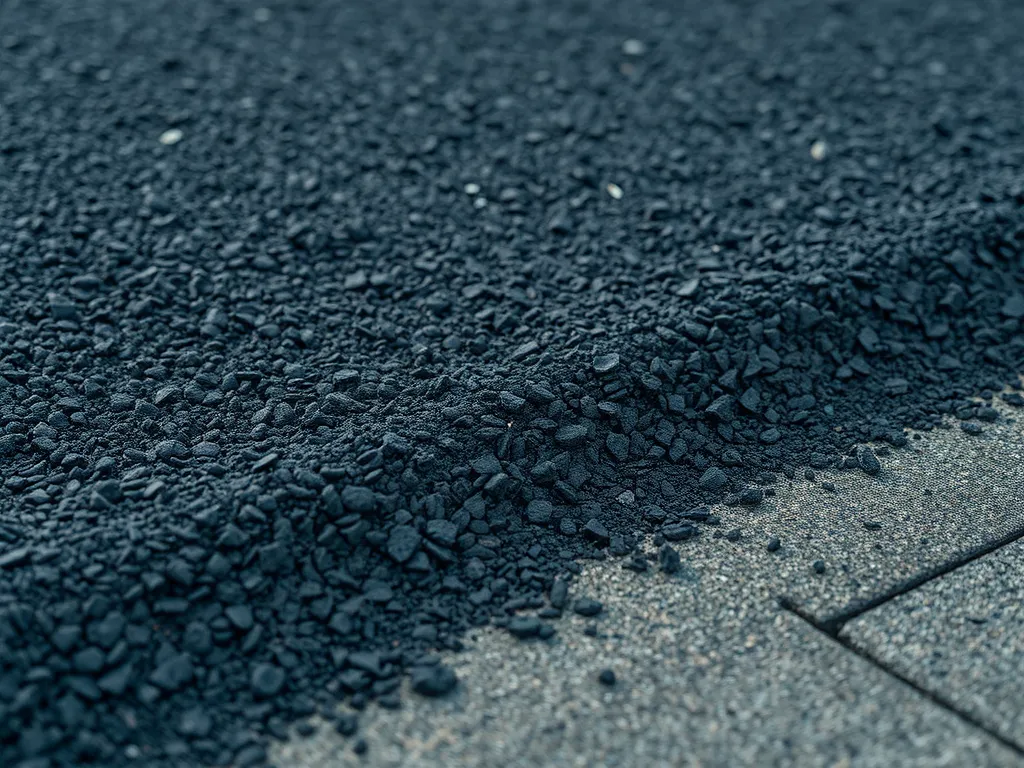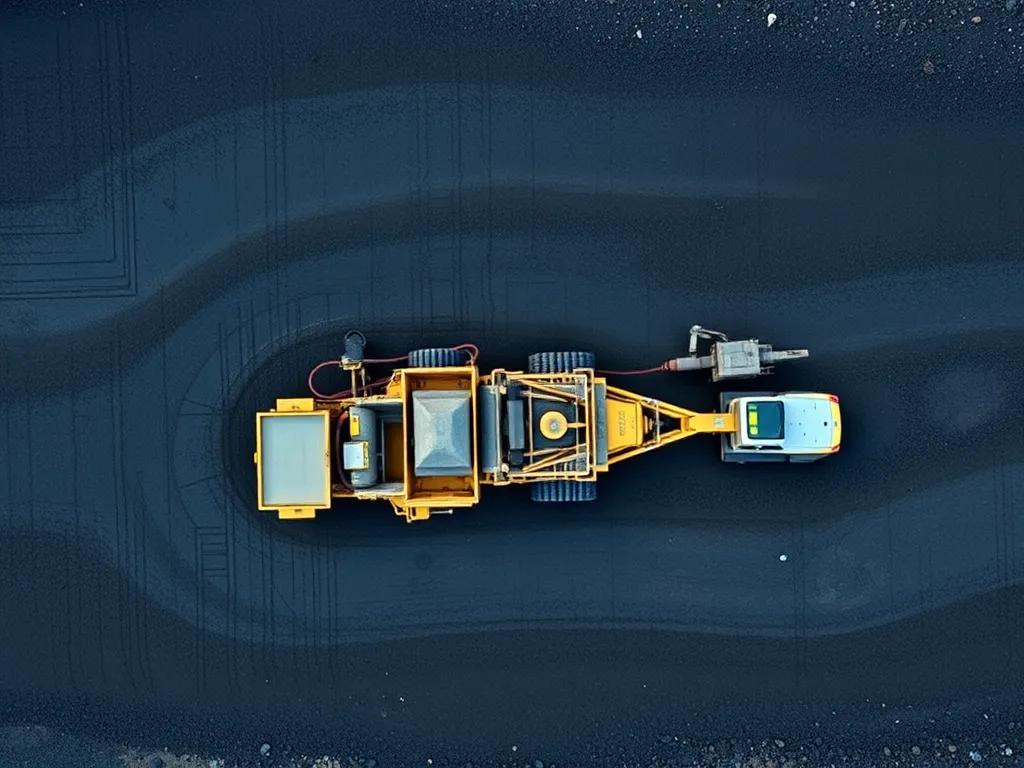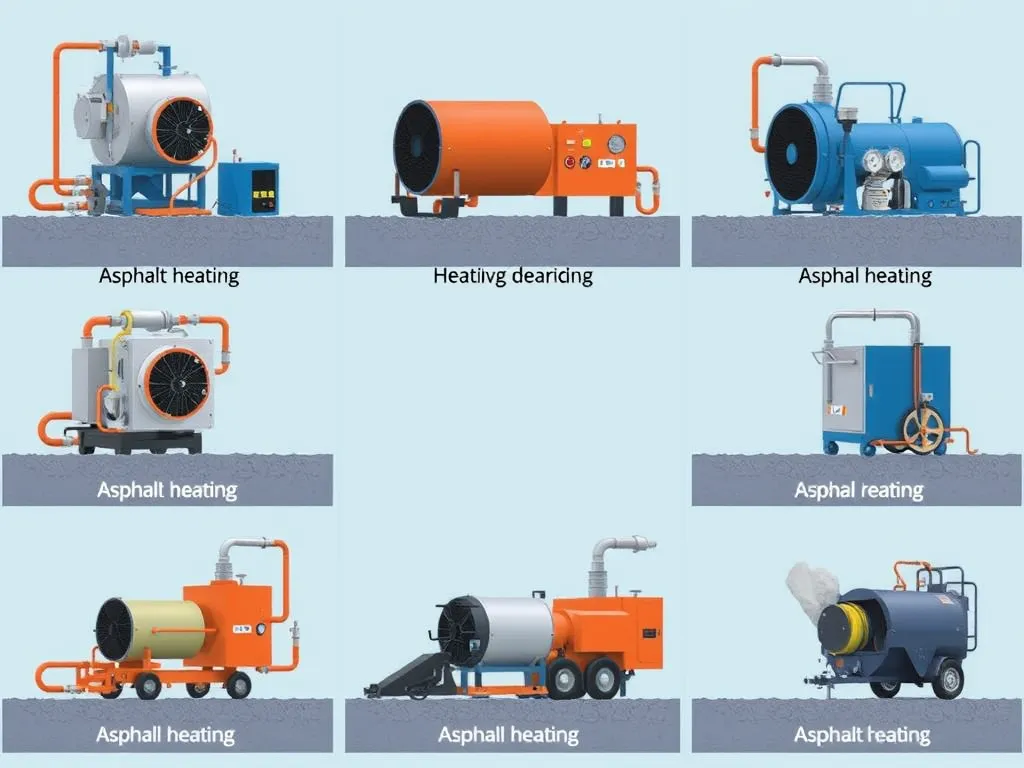Best Practices for Edge and Joint Aesthetics in Asphalt: Expert Tips for Flawless Results
Published on: August 29, 2025 | Last Updated: April 14, 2025
Written By: George Voss
Edge and joint aesthetics in asphalt refer to techniques that create clean transitions between pavement sections and adjacent surfaces like concrete or soil. These methods prevent water infiltration, reduce cracking risks, and improve visual continuity. Key practices include achieving 95% compaction density at edges, using polymer-modified PG 64-22 binders, and maintaining 300-350°F mix temperatures during placement. Proper execution extends pavement life by 15-20 years while eliminating uneven surfaces.
This article explains how to master edge and joint finishing for driveways, roads, and parking lots. You’ll learn base preparation standards, infrared joint heating processes, and solutions for raveling or color mismatches. We cover material selection with recycled asphalt (RAP), edge roller specifications, and cost-saving strategies that cut labor hours by 30%. Follow these pro methods to transform rough seams into smooth, durable transitions.
Contents
- Importance Of Edge and Joint Aesthetics in Asphalt
- Preparing Asphalt Edges and Joints
- Techniques for Achieving Quality Edge Aesthetics
- Enhancing Joint Aesthetics in Asphalt
- Troubleshooting Common Aesthetic Issues
- Recommended Tools and Materials
- Environmental Considerations
- Frequently Asked Questions (FAQs)
- Closing Thoughts
- Useful References for You:
Importance Of Edge and Joint Aesthetics in Asphalt
Smooth transitions at asphalt boundaries do more than boost curb appeal. Strong, tight joints and crisp lines shield pavements from water intrusion, shifting loads, and daily stress. Ignoring this risks costly fixes and a sloppy finish.
Impact on Durability and Visual Appeal
Quality joint aesthetics start with how materials bond. A 2-inch drop-off at a joint cuts pavement lifespan by up to 40% due to water pooling. Using PG 64-22 binders or Superpave mixes—designed for local climates—improves crack resistance. For visual harmony, match aggregate size (e.g., ½-inch stone) across adjacent sections. Rough or misaligned edges invite raveling, while crisp lines align with architectural edge details seen in projects by firms like Johnson Cousins Architecture.
Role in Preventing Structural Failures
Weak joints act as fault lines. Without lateral support, asphalt crumbles under truck traffic. Properly compacted edges (95% density) distribute loads and stop cracks from spreading. A ¼-inch gap at a cold joint can widen to 1 inch in two winters. Infrared heating fixes this by fusing old and new asphalt at 300°F, creating monolithic strength.
| Poor Practice | Quality Practice | Outcome |
|---|---|---|
| 85% compaction | 95% compaction | No edge sinkage |
| Cold joint with no tack | Infrared-heated joint | 0% seam visibility |
| Random aggregate sizes | Uniform ¾-inch stone | Consistent texture |
With the basics covered, let’s look at how to prepare asphalt boundaries for lasting results.
Preparing Asphalt Edges and Joints
Edge and joint aesthetics start long before asphalt hits the pavement. Proper groundwork sets the stage for crisp lines and durable connections between pavement sections.
Base Preparation Techniques
A stable base prevents edge crumbling and joint separation. Two factors dominate: subgrade stability and targeted compaction at pavement boundaries.
Subgrade Compaction
Compact subgrades to 95% Proctor density using vibratory rollers. This creates a uniform platform that resists lateral shifting. Test moisture content within ±2% of optimum to avoid future settlement that creates uneven edges.
Edge Compaction Best Practices
Use tandem rollers with 80-85% coverage along edges. Maintain 275°F-300°F mat temperatures during compaction. Apply tack coats at 0.05 gal/sy rates to bond layers without overspill. These steps prevent ragged edges that mar visual continuity.
Material Selection and Mix Design
Mix composition directly affects edge definition and joint longevity. Target these specs for clean lines that hold shape under stress.
Optimizing Asphalt Film Thickness
Aim for 8-15 micron asphalt film thickness around aggregates. Too thin (below 6μ) causes raveling at edges. Too thick (above 18μ) leads to bleeding at joints. Use PG 64-22 binders in temperate zones for balanced flexibility.
Using SuperPAVE and High-RAP Mixtures
SuperPAVE mixes – designed for specific climate zones – maintain edge integrity under thermal stress. Blending 30-40% RAP with rejuvenators (0.3-0.5% by weight) preserves workability for crisp joint lines. These mixes reduce thermal cracking by 22% compared to conventional blends.
With base and materials optimized, attention turns to application methods that transform technical specs into visible results.

Techniques for Achieving Quality Edge Aesthetics
Smooth transitions between asphalt and adjacent surfaces demand precise execution. Poorly finished edges lead to premature cracking, water infiltration, and visual inconsistencies. Let’s explore proven methods to elevate edge details.
Edge Detailing Methods
Edge work requires balancing structural integrity with visual harmony. Contractors use three core approaches: mechanical edgers, hand tools, and strategic mix adjustments. Each method impacts the final appearance of architectural edge details.
Proper Feathering and Alignment
Feathering blends fresh asphalt into existing surfaces at 6:1 slopes (1/4″ per 1.5″). Use infrared thermometers to maintain 275-300°F mix temperatures during blending. Align edges using laser-guided screeds within ±1/8″ tolerance for seamless transitions between lanes or curbs.
Reducing Excess Material on Edges
Excess asphalt at edges causes bulging and uneven compaction. Operators should trim overhangs within 15 minutes of placement using heated asphalt lutes. For cold joints, apply tack coats at 0.05 gal/sy rates before adjoining new material.
Tools for Edge Finishing
Specialized equipment ensures crisp lines and density matching. A 2023 NAPA study found proper tooling improves edge longevity by 40% compared to manual methods.
Joint Rollers and Compaction Equipment
8-10 ton dual-drum rollers achieve 92-96% density on edges. For tight spaces, use 36″ vibratory plate compactors operating at 4,000-6,500 VPM. Key specs:
- Edge roller temperatures: 250-275°F
- First pass within 3 minutes of placement
- Overlap passes by 50% width
While edge finishing sets the stage, joint construction demands equal precision. Up next: methods to create invisible transitions between asphalt sections.
Also See: Asphalt Sustainability Initiatives for Safer Roads
Enhancing Joint Aesthetics in Asphalt
Clean lines and tight joints boost curb appeal while blocking water damage. Poor joints lead to cracks, uneven wear, and costly fixes. Focus on heat, tools, and timing to merge sections smoothly.
Joint Construction Best Practices
Strong joints start with fresh layering and exact tool use. Match temps and mix types to avoid gaps or weak spots.
Hot vs. Cold Joint Techniques
Hot joints bond fresh asphalt to warm existing layers. Use lutes or rakes to blend edges before rolling. Cold joints form when new asphalt meets cured layers. Apply tack coats (like SS-1h) for grip. Heat both edges to 250°F for better fusion.
Controlling Joint Width and Alignment
Keep joints under 0.25 inches wide. Use joint rollers with guide rails for straight lines. Check alignment with laser levels every 10 feet. Offset edges by more than 0.5 inches? Reheat and re-roll.
Sealing and Finishing Joints
Seal joints within 24 hours to block moisture. Pick sealers based on traffic load and climate. Avoid cheap fillers—they crack in 6-12 months.
Infrared Heating for Seamless Blending
Infrared heaters fix gaps up to 3 inches wide. Heat edges to 300°F for 5-10 minutes, then rework the mix. This method cuts repair costs by 40% vs. full-depth patching.
Avoiding Dull or Cloudy Surfaces
Dull spots stem from low mix temps or overworked edges. Keep rollers moving—stopping burns the surface. Apply fog seals with polymer blends to restore shine without stickiness.
Even top-grade methods face challenges. Next, let’s tackle common flaws like crowning and raveling in problem zones.

Troubleshooting Common Aesthetic Issues
Even with precise techniques, edge and joint flaws can emerge. Spotting these problems early prevents long-term damage to both appearance and structural performance.
Crowning in Joints and Edges
Crowned edges form raised ridges along longitudinal joints, often from uneven compaction or temperature mismatches. Use joint rollers at 280-300°F to maintain 92% density across seams. For existing crowning, apply infrared heaters to rework the surface, followed by steel-wheel roller passes. Ensure base layers slope 1/8” per foot away from the centerline to promote water runoff.
Raveling and Scaling Prevention
Loose aggregate at edges signals raveling, typically caused by low binder content or premature traffic loads. Tack coat application rates of 0.05-0.07 gallons per square yard boost adhesion between layers. Opt for polymer-modified binders like PG 76-22 in freeze-thaw zones. Superpave mix designs with 19mm nominal aggregate size reduce scaling risks by 40% compared to larger stone blends.
Addressing Poor Mix Quality
Inconsistent mixes lead to blotchy edges or weak joints. Verify PG binder grades match regional climate specs—PG 64-16 works for most temperate zones. Test RAP content limits; exceeding 25% recycled material requires rejuvenators to restore maltenes. Track plant discharge temps: 275°F for standard mixes, 300°F for high-RAP batches.
Texture and Color Consistency Fixes
Mismatched textures stem from erratic paver speeds or roller timing. Maintain 8-12 feet per minute paving rates for uniform mat texture. For color shifts, blend 2% synthetic iron oxide additives into the top lift. Use infrared joint repair systems to fuse new and existing asphalt, achieving seamless architectural edge details. Aggregate gradations within ±3% of target specs prevent visible banding.
Up next: Explore the tools that turn these fixes into lasting results.
Recommended Tools and Materials
Selecting the right tools ensures crisp edges and smooth transitions between asphalt sections. Proper equipment choices directly affect longevity, texture consistency, and visual harmony across surfaces.
Essential Compaction Equipment
Vibratory rollers (8-12 tons) with 3,000-4,500 VPM frequencies create uniform density along edges. Plate compactors (90-140 lbs force) target tight spaces near curbs or barriers. Use tandem rollers for longitudinal joints to achieve 92-96% density. Under-compacted edges lead to raveling, while over-compaction causes surface fractures.
| Tool | Specs | Application |
|---|---|---|
| Vibratory Roller | 10-ton, 3,800 VPM | Edge density |
| Plate Compactor | 120 lbs, 75 Hz | Tight spaces |
| Tandem Roller | 8-ton static weight | Longitudinal joints |
Infrared Joint Repair Systems
Systems like Heatwurx or Kasi reheat existing asphalt to 300-325°F for seamless blending. This method bonds new material to old layers, eliminating visible seams. It reduces material waste by 15-20% compared to cold patching. For best results, maintain a 2-3″ overlap zone during reheating to ensure thermal fusion.
Color-matching Aggregate Solutions
Granite or limestone aggregates (3/8″ minus) blended with polymer-modified binders match existing surfaces. Additives like iron oxide pigments adjust hue for uniformity. High-RAP mixes (30-40% recycled content) maintain color consistency when paired with fresh binder layers. Test samples under UV light to verify color stability before full-scale application.
Proper tool selection sets the stage for environmentally conscious practices. Next, explore methods to integrate recycled materials without sacrificing edge integrity.

Environmental Considerations
Balancing sustainability with sharp edge lines and seamless joints requires smart material choices and updated methods. Modern asphalt work now blends eco-conscious strategies with precise finishing to maintain visual and structural standards.
Recycled Asphalt (RAP) Integration
Recycled asphalt pavement (RAP) cuts waste by reusing 30-40% of old asphalt in new mixes. For edge and joint work, RAP demands strict temperature control – heated to 275°F–325°F – to bond properly without cracking. Pair RAP with PG 64-22 binders to enhance flexibility, critical for cold joints or curved edges. Test mixes with 15% RAP first to avoid surface inconsistencies that lead to raveling or color mismatches at seams.
- Use infrared heaters to reactivate RAP edges before joining new layers
- Add 1-2% rejuvenators to restore aged binder elasticity
- Avoid over-milling RAP edges; keep aggregate size under ½” for smooth feathering
Eco-friendly Compaction Techniques
Low-emission vibratory rollers (8-12 Hz frequency) achieve 92-95% density without sacrificing edge integrity. Electric plate compactors target joints with 5,000-8,000 lbf force, reducing air voids below 7% to prevent water infiltration. For narrow edges, opt for propane-powered tampers – they emit 20% fewer particulates than diesel models while maintaining 3/8” alignment tolerances.
- Apply warm-mix asphalt additives (Evotherm® or Sasobit®) to lower compaction temps by 50°F
- Use geotextile-reinforced bases under edges to minimize material waste
- Track carbon output with compaction telematics – aim under 15 kg CO2 per ton laid
Mastering these green methods ensures crisp architectural edge details while meeting modern environmental benchmarks. Next, we’ll explore troubleshooting strategies for common flaws that undermine quality joint aesthetics.
Frequently Asked Questions (FAQs)
What is the First Step in Creating Asphalt Edge Joints?
The initial step in creating asphalt edge joints involves proper base preparation, including ensuring subgrade stability and compaction to the appropriate density. This foundation is crucial for achieving clean and durable edges when the asphalt is laid.
How to Achieve Seamless Joints Between Asphalt Sections?
To achieve seamless joints between asphalt sections, it’s essential to use hot joint techniques, aligning the temperatures of the new and existing asphalt. Applying a tack coat before jointing and ensuring adequate compaction of the edges will also help in achieving a smoother transition.
What Methods Prevent Raveling in Asphalt Joints?
To prevent raveling in asphalt joints, maintaining adequate binder content and ensuring proper compaction are key. Utilizing polymer-modified binders and applying tack coats can enhance the adhesion between layers, thereby minimizing the risk of loose aggregates and raveling.
How Important is Temperature Control During the Asphalt Laying Process?
Temperature control during the asphalt laying process is critical for achieving proper compaction and bonding of materials. Keeping the mix within specified temperature ranges helps prevent premature cooling, which can lead to inadequate compaction and joint weakness.
What Role Does Recycled Asphalt Play in Edge and Joint Aesthetics?
Recycled asphalt (RAP) can enhance edge and joint aesthetics by reducing waste and maintaining the integrity of the asphalt mix. When properly processed and combined with new materials, RAP can achieve a consistency that matches existing surfaces, promoting visual continuity.
How Can I Identify Issues With Texture and Color Consistency?
Issues with texture and color consistency can be identified by visually inspecting the asphalt surface for blotchiness or uneven color distribution. Regular monitoring of mix quality, particularly during paving, and using color-matching aggregates can help maintain uniformity.
What Are the Benefits Of Using Infrared Heating During Joint Repairs?
Infrared heating during joint repairs provides several benefits, including the ability to seamlessly blend new and existing asphalt while preventing the formation of visible seams. This method also helps in reducing repair costs and material waste, making it an efficient solution for maintaining joint aesthetics.
Closing Thoughts
Achieving optimal edge and joint aesthetics in asphalt requires careful attention to detail. Start with a solid base and effective compaction techniques. Select quality materials and ensure proper mix design. Incorporating best practices for joint construction and finishing will elevate both the durability and appearance of your asphalt surfaces.
Regular inspection and maintenance can prevent many aesthetic issues, keeping your asphalt looking great for years. By prioritizing these aspects, you’ll not only enhance visual appeal but also extend the lifespan of your asphalt. For further insights and specialized tools, visit Asphalt Calculator USA.
Useful References for You:
- Kett, I. (1999). Asphalt Materials and Mix Design Manual. Oxford: Elsevier Science.
- Aesthetic Edge | HealthShare
- Simple edge to face joint | Woodworking Talk
- Master Edge Jointing: Shop-Proven Hand Planing Techniques
- The Edge Aesthetics & Co. – The Edge Aesthetics & Co. – St. Johns, FL


